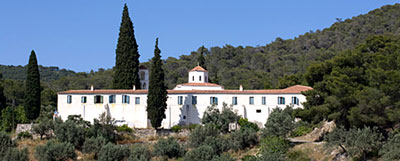 Monasteries and Churches
Monasteries and Churches
 Moní Hozoviótissa, Amorgós
Moní Hozoviótissa, Amorgós
An architectural triumph built into the Prophítis Ilías mountainside, this 11th-century monastery was built for the Virgin Mary, protector of Amorgós island. It contains sacred treasures, including a 15th-century icon of the Virgin Mary. Resident monks host a festival here every 21 November.
- Near Amorgós Town
 Moní Zoödóchou Pigís, Póros
Moní Zoödóchou Pigís, Póros

Moní Zoödóchou Pigís
This 18th-century monastery is called Zoödóchos Pigi (meaning life-giving) because it is built around a curative spring. This white structure, surrounded by pine forest, is an appealing sight. The fine collection of icons and the intricately carved gilded iconostasis separating the nave from the sanctuary are noteworthy.
- Póros Town
 Néa Moní, Híos
Néa Moní, Híos

Detail, Néa Moní
A UNESCO World Heritage Site, this austere monastery was built in the 11th century by Byzantine emperor Constantine IX Monomacho on the site where a miraculous icon of the Virgin Mary was discovered. It is noted for its superb mosaics, considered among the finest Macedonian Renaissance art in Greece (For further details see Néa Moní, Híos).
 Moní Platytéra, Corfu
Moní Platytéra, Corfu
Dedicated to the Virgin Mary and to saint Chrysanthos, this 18th–19th-century monastery has post-Byzantine icons by famous local painters Klontzás and Ventoúras. It houses the mausoleum of the first Governor of Greece, Ioannis Kapodistrias, a Corfiot who took office in 1827.
- Corfu Town
 Moní of the Panagía Odigítria, Lefkáda
Moní of the Panagía Odigítria, Lefkáda
Built in the 1400s and noted for its traditional single-aisle architecture, austere exterior and intricate timber roof, this monastery is the island’s oldest. It is dedicated to Odigítria, an ancient name for the Virgin Mary depicted in religious icons.
- Lefkáda Town
 Moní Panagía of Vlachérna, Corfu
Moní Panagía of Vlachérna, Corfu
A landmark of Corfu, this white monastery stands on an islet in the Chalikópoulos Lagoon off Kanóni. It is reached by a small causeway. This 17th-century monastery, which has also been a convent, has interesting architectural features and ecclesiastical icons.
- Kanóni
 Moní Katharón, Itháki
Moní Katharón, Itháki
Believed to originate from before the 17th century and built at an altitude of 600 m (1,970 ft), this monastery is one of the oldest and highest in the islands. Remote and beautiful, it was renovated after the earthquake of 1953 and is dedicated to the Virgin Mary.
- Anogí
 Moní of St John of Lagadá, Zákynthos
Moní of St John of Lagadá, Zákynthos
Frescos and gilded iconostasis, which date back centuries, make the journey to this remote and atmospheric monastery worthwhile. Built in the 16th century and remodelled in the 17th, it had many houses and chapels at one time. Today it is home to just one monk.
- Katastári
 Moní Transfiguration of the Saviour, Zákynthos
Moní Transfiguration of the Saviour, Zákynthos
This Byzantine monastery, dedicated to Ágios Dionýsios, the patron saint of Zákynthos, is an isolated structure on the island of Stamfáni in the Strofádes, a mini archipelago that belongs to the Greek Orthodox Church.
 Moní Agíou Gerásimou, Kefalloniá
Moní Agíou Gerásimou, Kefalloniá
A white-walled, red-roofed structure on the Mount Enos foothills, this monastery is dedicated to Gerásimos, Kefalloniá’s patron saint. According to legend, Gerásimos lived in nearby caves. His mausoleum is in the monastery.
- Frangáta